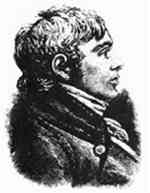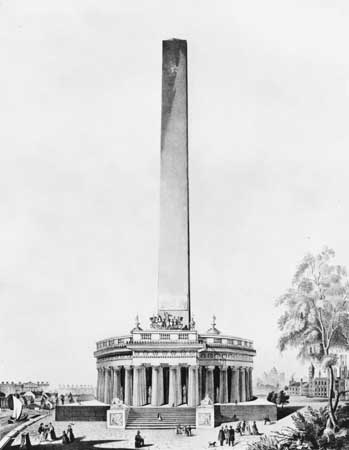<Back to Index>
- Physicist Erwin Rudolf Josef Alexander Schrödinger, 1887
- Architect Robert Mills, 1781
- Dictator of Pakistan Muhammad Zia-ul-Haq, 1924


Robert Mills (August 12, 1781 – March 3, 1855) is sometimes called the first native born American to become a professional architect, though Charles Bulfinch perhaps has a clearer claim to this honor. Mills studied in Charleston, South Carolina, as a student of Irish-born architect James Hoban who later designed the White House which became the official home of US presidents. Both Hoban and Mills were Freemasons.
Born in Charleston, South Carolina, Mills moved to Philadelphia in 1802, where he became an associate and student of Benjamin Henry Latrobe. He gradually became known in his own right. Some Philadelphia buildings that he designed are Washington Hall, Samson Street Baptist Church, and the Octagon Church for the First Unitarian Church of Philadelphia. He also designed the Upper Ferry Bridge covering.
In 1812, Mills designed the Monumental Church in Richmond, Virginia, which was built to commemorate the death of 72 people in the Richmond Theatre. This incident sparked his later interest in fireproofing measures.
Moving to Baltimore, he designed St. John's Episcopal Church, the Maryland House of Industry, and the Maryland Club. He is noted for designing the nation's first Washington Monument, in Baltimore, which began construction in 1815.
In 1820, he was appointed as acting commissioner of the Board of Public Works in South Carolina. In 1823, Mills was the superintendent of public buildings. In the next few years, he designed numerous buildings in South Carolina including court houses, the campus of the University of South Carolina, jails, and the Fireproof Building in Charleston. In 1825, he authored an Atlas of the State of South Carolina. One year later, he published Statistics of South Carolina.
In 1836 he won the competition for the design of the Washington Monument which is his best known work. He also designed the Department of Treasury building and several other federal buildings in Washington, D. C. including the U.S. Patent Office Building. In South Carolina, he designed county courthouses in at least 18 counties, some of the public buildings in Columbia, and a few private homes. He also designed portions of the Landsford Canal, Chester County, on the Catawba River in South Carolina. Mills was an early advocate of buildings designed to include fireproof materials. A fire in Kingstree, South Carolina, destroyed much of the upper floor of a courthouse called the Fireproof Building which
had been designed by Mills, but the county records on the first floor
were protected due to his fireproofing measures. A fire also destroyed
much of the Lancaster County, South Carolina Courthouse in August 2008. He died in Washington, D.C. in 1855 and was buried at the Congressional Cemetery. The broadest context for Mills' architecture was neoclassical architecture. This was the dominant style of building that was winning architectural design competitions and major projects of the time, both in Europe and in America. Under the umbrella of neoclassicism, his designs were partly Palladian, Georgian and often Greek Revival. Apart
from stylistic movements in architecture going on in the world at his
time, Robert Mills was involved in the more local context of building
in the Mid-Atlantic States.
There, and especially in Washington D.C., were many figures
contributing architecture of high quality. To build as Mills did on
what is now the National Mall, he had to contend with the planning strictures of Pierre Charles L'Enfant, as well as Andrew and Joseph Ellicott. Being an architect of the now Baltimore-Washington Metropolitan Area he was also undoubtedly influenced by Thomas Jefferson and Jeffersonian architecture. Mills, with Jefferson and others, was able to create a distinctive federal style of architecture.